
|
John A. Weeks III
Wednesday, January 14, 2026, 9:13:38 AM CST |
|||
| Home | Photo Tours | Rail Fan | 12 Easy Steps |
| Aviation | Spacecraft | Highways & Bridges | About The Author |

|
|
|||||||||||||||||
Big Cat Photo Tour
In addition to photographing airplanes and bridges, I enjoy doing zoo
photography. Zoo photography is a little more challenging because you
have to work with natural light, the enclosures are often in the way,
you cannot pose the subjects, and the zoo visitors get in the way. The
end result of a good shot is a photo that looks like it was taken in
the wild. Here is a group of my favorite big cat photos from the 1989
to 1993 era. Note that these are copyrighted photos and may not be
used without written permission.

This African Lion is at the Indianapolis Zoo, located in Whitewater State
Park near downtown Indianapolis, Indiana. This is a relatively new zoo having
been founded in 1968, and being at its current location since 1988. It is
not an overly large zoo, but each exhibit is well done. The Indy Zoo is a
member of the Species Survival Plan for the African Lion. This lion is doing
what a male lion does the most...lounging around on his favorite rock.
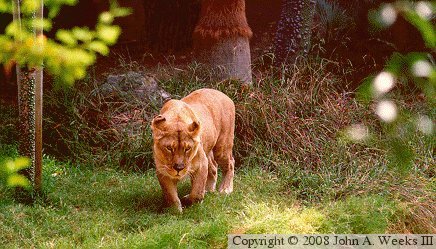
This female African Lion at the Los Angeles Zoo, located in
Griffith Park just northwest of downtown LA. This zoo is also relatively
new, having been founded in 1966. Zoo LA is a very large facility with
a wide variety of animals. The warm climate allows the zoo to grow a
wide variety of plants that are native to the areas where the animals
would live in the wild. This makes the zoo photos look a little more
authentic. In this photo, the lioness is on patrol walking around her
habitat waiting for an early morning meal.

This is a tiger at the cat complex at the Henry Doorly Zoo, located
on the west side of Omaha, Nebraska. The Henry Doorly Zoo is one
of the oldest zoos in America, and it is famous as the home zoo of
Marlin Perkins, host of ‘Mutual of Omaha’s Wild Kingdom’. The
cat complex was the largest cat facility in America when it
opened in 1977. It is a key facility in supporting the Tiger Species Survival
Plan. This tiger is doing what cats do the best, and that is sleep.
A tiger may sleep 18 hours a day. Since a tiger has no natural predators,
it doesn’t have to worry about being attacked when sleeping.
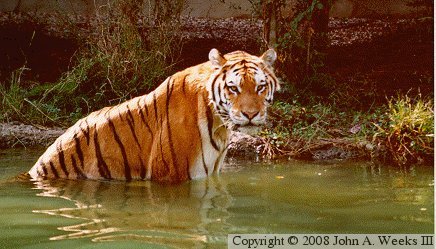
This Siberian tiger is taking a dip in the pool at the zoo in Houston, Texas.
The Houston Zoo dates back to the early 1900s, but the bulk of its exhibits
were built shortly after WWII. Animal exhibits from that era were mostly
cages with bars and concrete. A large effort was made by the zoo in the
1980s to update these old exhibits into habitats that are much more animal
friendly. In this photo, the tiger is out for a swim on a very hot and muggy
morning, shooting down the myth that tigers do not like the water.
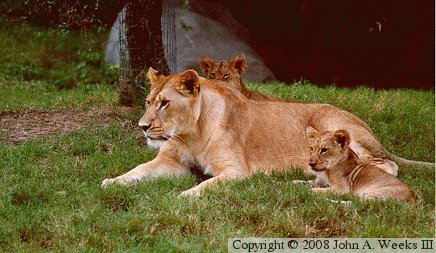
This is another photo from the Houston Zoo from October, 1991, showing a lion
with her cubs. These cubs are both females. There is a 3rd cub, a male, who
is hiding behind a rock just behind his mother’s tail. The cubs were
6 weeks old at the time, and this was the very first day that they were on
display. The crowd appears to be a little too close for comfort based on
the mother’s intense stare towards the crowd. As a result, keepers
brought the lions in after about two hours.

These are two young male leopards located at the Houston Zoo. Leopards
carry spots, but the spots are a complex pattern called a rosettes rather
than simple solid spots. The spots are in the hair only, and not on the
leopard’s skin. This is in contrast to the tiger and jaguar, where the
spots are on their skin as well as in their coat. Leopards like to sleep
much of the day. They search out spots where there are high outcroppings of
rocks to give them good visibility and a place that they can defend. As a
result, leopard habitats are normally built with a similar rock outcropping.
Leopards are considered to be one of the four ‘big cats’ along
with tigers, lions, and jaguars.
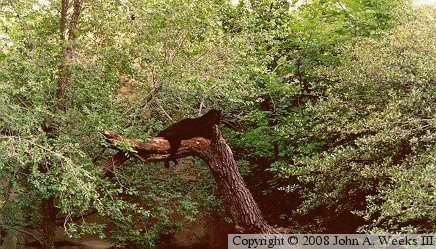
This jaguar is at the Brookfield Zoo in the western suburbs of Chicago,
Illinois. The Brookfield Zoo dates from the depression era, and it once
consisted of the worst of the cage and bar type exhibits. New ideas came to
the zoo in the 1980s, and at one point, the zoo was all but shut down for
much of a 3 year period as the bulk of the cage and bar exhibits were removed
and modern habitats were built. The result is very modern zoo that is also
very easy for the visitors to see everything. The zoo features one of the
first indoor tropical exhibits, which is worth the trip by itself. This
jaguar is known as a melanistic, which is a genetic variation that leaves the
cat with a black coat. This cat spends a lot of time in this tree. At times,
it faces away from the crowd so it can watch the keepers and see when lunch
is being served. At other times, it faces towards the crowd to watch the zoo
visitors.
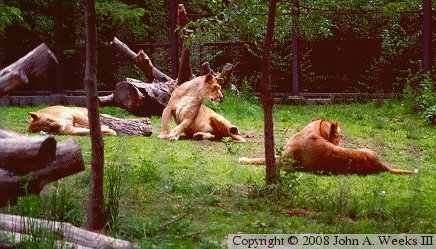
These three young lions are on display in the Lion’s Pride exhibit at
the World Famous Topeka Zoo in Topeka, Kansas. This zoo is known for its
innovative exhibits, unusual for such a small zoo. As an example, the Topeka
Zoo has one of the first indoor tropical rainforest exhibits. This photo was
taken shortly after the Lion’s Pride opened in 1989. Zoo keepers put
the male and female lions outside on alternate days. The Topeka Zoo ran into
a period of mismanagement and neglect in the late 1990s, and it lost
accreditation in 2001. The city of Topeka was forced to replace the
management and revamp the facility in order to regain its accreditation. The
end result is a much more modern and animal-friendly facility.
|
|
|
Authored by John A. Weeks III, Copyright © 1996—2016, all rights reserved. For further information, contact: john@johnweeks.com
|